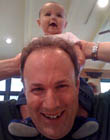|
|
This topic comprises 2 pages: 1 2
|
|
Author
|
Topic: Spacing Between Amplifiers
|
James R. Hammonds, Jr
Jedi Master Film Handler

Posts: 931
From: Houston, TX, USA
Registered: Nov 2000
|
 posted 05-04-2001 04:57 PM
posted 05-04-2001 04:57 PM




Does anyone have any suggestion on how much space should be left between each amplifier in the sound rack?My theatre uses CROWN COM-TECH amplifiers and we have had many problems with channels going out. My manager thinks that they might be getting too hot because they are stacked on top of each other, but I didn't think it mattered since there is no ventilation on the top or bottom; just on the front. Our booth is at a proper temperature, so I don't think that is the problem. Any ideas?
| IP: Logged
|
|
|
|
|
|
Randy Stankey
Film God

Posts: 6539
From: Erie, Pennsylvania
Registered: Jun 99
|
 posted 05-04-2001 05:22 PM
posted 05-04-2001 05:22 PM




I think poor ventillation is a possibility. It can't hurt to give the amps more breathing room.However, I'd check your speaker hookups for the proper impedance.
I know of several theatres that have their speakers (especially the surrounds) hooked up either all in series or all in parallel. This can cause a borderline overload (or sometimes an "underload") on the outputs which will cause the amps to overheat and fail prematurely. What you should do is check the specs of the amplifiers and make sure the impedance of the speaker hookups matches the amps' specs as closely as you can manage. This means that you'll have to hook the speakers up in some kind of series-parallel arrangement. Yes, you'll have to get out your calculator and a pencil and paper and do y'erself some good ol' fashioned cipherin'. If you have an odd number of speakers you might only be able to get the impedance to come out to 6.667 ohms but that's a whole lot better than some wierd value like 3.334 ohms. Even though some amps say they can tolerate loads as low as 2 ohms I don't think they mean that they can do it all the time. Besides they'll run a whole lot cooler and they'll probably sound a little bit better as well.
PS: Why can't this board parse the ohms symbol? (?) -- Just wondering.
| IP: Logged
|
|
|
|
|
|
|
|
Steve Guttag
We forgot the crackers Gromit!!!

Posts: 12814
From: Annapolis, MD
Registered: Dec 1999
|
 posted 05-04-2001 09:47 PM
posted 05-04-2001 09:47 PM




The Crown Com-Techs can be stacked right on top of one another. It has thermal sensors on the heat sinks to control the fan. The fan draws in from the front (hopefully through a routinely cleaned filter) and blows out the sides.I have to repair quite a few of the Crowns based on that platform (Macro, Micro and Com-Tech)....their failure mode can be rather nasty...if the output devices fail...the will often take out the main module as well. Crown also tends to beta test in the field...if you have an early version of their amplifier then they are still in the testing phase...If you ever look at their service manuals....there are often several revisions until the settle on the final version. Crown also often will settle for a marginal componet in their amplifiers...that is, if the theoretical wattage for a resistor is .497 watts....they will just use a 1/2 watt resistor...I'm sure some bean counter can show the cost savings and the amplifier will make it out of warranty before it fails. As to impedance...the Com-Tech should deal with 2-Ohms just fine btw. Randy, you are incorrect in that many amplifiers nowadays will run just fine into 2-Ohms...in fact, the QSC DCA-1222 will run just fine into 1.6 Ohms...all day long! Looking at the spec sheets you can often tell if it really can handle 2-Ohms...if they are willing to give a 20-20KHz spec on 2-Ohms it can probably handle it just fine...if they only like the 1KHz spec, it won't necessarily catch fire but you are bound to be heating it up a bit. As to surround speakers, you should ALWAYS avoid series connections, IF your amplifier can handle the load. A series connection will introduce a sloppy bass response since this series bass will be very signifigant to the damping factor (a normally worthless figure in amplifiers). An experiment to try at home is to take an 8-Ohm resistor and put it in series with your speakers...listen for the difference in the bass response (some people actually prefer the sound). Steve ------------------
"Old projectionists never die, they just changeover!"
| IP: Logged
|
|
Randy Stankey
Film God

Posts: 6539
From: Erie, Pennsylvania
Registered: Jun 99
|
 posted 05-04-2001 10:18 PM
posted 05-04-2001 10:18 PM




I stand corrected, then. I know that even though some amplifiers say they'll run at a certain, low impedance they can't take it for long. I guess the answer is to check your amplifier specs.Still, I stand by what I said earlier. You should at least check to be sure that you don't have an impedance problem.
Darryl;
Yes, I was in Salisbury just yesterday. I talked to Don. He had nothing but good things to say about you... no kidding!  I was telling him that there are certain theatres that I NEVER hear from and that when I pick up my phone and see the name of one of these theatres displayed I say to myself, "Oh, Sh**! What's wrong?!" Don said that when Bob D. comes to your theatre it's almost like a vacation for him because there's nothing for him to do! I was telling him that there are certain theatres that I NEVER hear from and that when I pick up my phone and see the name of one of these theatres displayed I say to myself, "Oh, Sh**! What's wrong?!" Don said that when Bob D. comes to your theatre it's almost like a vacation for him because there's nothing for him to do!
| IP: Logged
|
|
|
|
|
|
Steve Guttag
We forgot the crackers Gromit!!!

Posts: 12814
From: Annapolis, MD
Registered: Dec 1999
|
 posted 05-06-2001 11:32 AM
posted 05-06-2001 11:32 AM




Many Crown amplifiers can actually do 1-Ohm in their goofy parallel mode (both outputs are strapped together)...not that I think this is the best situation but they are rated for it (at least the Macro-Techs are)....I agree with the others on checking the impedance (or even just the resistance can tell you pretty much what is going on)...a proper impedance bridge can let you see what is going on by frequency though. Another thing to remember when running surrounds at these low impedances is to have large enouch wire to handle the current load and not contribute significantly to the overall resistance of the system. If your typical surround speaker can take 100 watts (at 8-Ohms) then there will be at maximum just over 3.5 amps on the wire...Your wire needed be very large to handle the current load though you don't want it so small it acts too much like a resistor. However, if you take advantage of these new amps and run say 400 watts at 2-Ohms (4 100-Watt speakers in parallel) then the current leaving the amplifier jumps to over 14 amps! This puts you at 14awg for current considerations. If you use the QSC DCA-1222 with 5 8-Ohm speakers you now are up to nearly 18 Amps...and 12awg minimum. The above should point out why one should use "home-run" lines rather than a series/parallel in the theatre. Power though the wire is expressed as current^2 x Resistance of the wire. Since current causes the power loss in the wire itself to move with the square of the current, it is best to have the current in the wire as low as possible since it is the dominent factor. Steve ------------------
"Old projectionists never die, they just changeover!"
| IP: Logged
|
|
|
|
|
|
|
|
|
|
All times are Central (GMT -6:00)
|
This topic comprises 2 pages: 1 2
|
Powered by Infopop Corporation
UBB.classicTM
6.3.1.2
The Film-Tech Forums are designed for various members related to the cinema industry to express their opinions, viewpoints and testimonials on various products, services and events based upon speculation, personal knowledge and factual information through use, therefore all views represented here allow no liability upon the publishers of this web site and the owners of said views assume no liability for any ill will resulting from these postings. The posts made here are for educational as well as entertainment purposes and as such anyone viewing this portion of the website must accept these views as statements of the author of that opinion
and agrees to release the authors from any and all liability.
|

 Home
Home
 Products
Products
 Store
Store
 Forum
Forum
 Warehouse
Warehouse
 Contact Us
Contact Us




 Printer-friendly view of this topic
Printer-friendly view of this topic













 I was telling him that there are certain theatres that I NEVER hear from and that when I pick up my phone and see the name of one of these theatres displayed I say to myself, "Oh, Sh**! What's wrong?!" Don said that when Bob D. comes to your theatre it's almost like a vacation for him because there's nothing for him to do!
I was telling him that there are certain theatres that I NEVER hear from and that when I pick up my phone and see the name of one of these theatres displayed I say to myself, "Oh, Sh**! What's wrong?!" Don said that when Bob D. comes to your theatre it's almost like a vacation for him because there's nothing for him to do!




